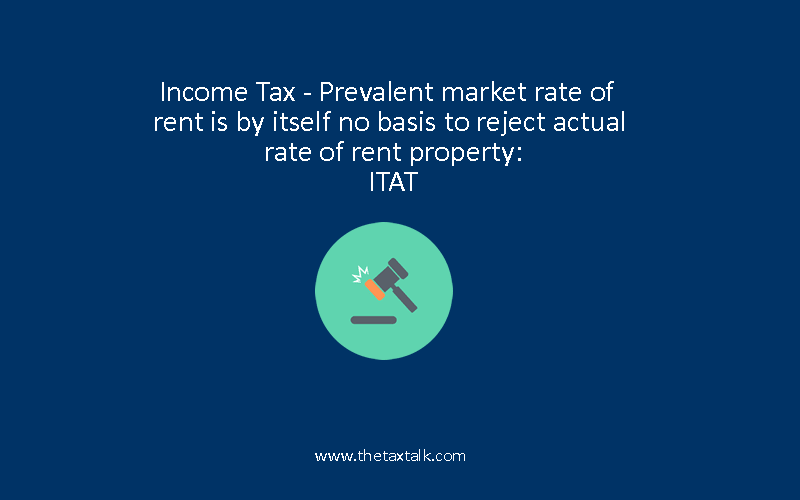![]()
Income Tax – Prevalent market rate of rent is by itself no basis to reject actual rate of rent property: ITAT
MUMBAI, JUNE 21, 2018: THE issue at hand before the bench is whether rate of rent prevailent in the market is per se basis enough to override the actual rent of a property. Another issue is whether the prevailent rent would prevail over the actual rate without there being any evidence or material showing that the prevailent rate had been suppressed. NO is the answer.
Facts of the case
During assessment for the relevant AY, the assessee company claimed that its only activities were by way of investments. In its returns for the relevant AY, the assessee received an amount of rental income which it declared as ‘Business Income’. It acquired tenancy rights of about 1634 sq feet in a particular building. It later leased out a portion of the same to its sister company. Apart from monthly rent, the assessee also received an amount as rent deposit from its sister unit. This rental income was disclosed as ‘Business income’ and the rent paid for the property as well as expenses required for running of the company was claimed as deduction.
The AO completed assessment and passed an order u/s 143(3). Subsequently, the AO reopened the assessment and proceeded to make additions on account of I ncome from House Property. The AO opined that such income was taxable as ‘Income from House Property’, as assessee was to be treated as owner of the house property u/s 27(iiib). The AO also differed with the assessee to treat the actual rent received as the annual value of the property for the purposes of Section 23. The AO also noted that the fair rent of the property was higher than the stated rental. Thereupon the AO calculated the actual rent at a figure considerably higher than that declared by the assessee and also the annual value of the property. On appeal against such findings, the CIT(A) upheld the reopening of assessment as well as the additions made.
On appeal, the Tribunal held that,
++ the short-point for our consideration is as to whether the Assessing Officer was justified in rejecting the value declared by the assessee and instead, determining the annual value of the property for the purposes of Sec. 23 of the Act based on estimation arrived at by him, having regard to the two instances noted in the vicinity of assessee’s property; In this factual background, the claim of the assessee is that the actual rent be taken as the annual value of the property as it exceeds the Municipal ratable value. The AO does not accept Rs 7,500/- per month as the value for which the property might reasonably be expected to be let. In such a situation, as held by the Bombay High Court in the case of CIT vs. Tip Top Typography , the AO is required to carry out necessary investigations and inquiries. It is further prescribed that the AO shall have cogent and satisfactory material in his possession “which indicate that the parties have concealed the real position”. It has been further explained that there must be “definite and positive material to indicate that the parties have suppressed the prevailing rate”. If we were to examine the case made out by the AO in the instant in the background of the above reasoning laid down by the Bombay High Court, it is found that there is no allegation, much less any positive material with the AO, to say that the assessee has suppressed the real position by declaring rent from the sister concern @ Rs.7,500/- per month. On the contrary, what we find is that without arriving at such satisfaction, the AO has proceeded to ascertain the going rate of the rentals in the vicinity of assessee’s property. Such approach is contrary to the judgment of the Bombay High Court in the case of Tip Top Typography , wherein the following discussion would indicate that ascertaining of the going rate in the market is not the basis to reject the actual rent declared, but rather there has to be a definite and positive material to indicate that the parties have suppressed the prevailing rate and the exercise of ascertaining the going rate would follow his satisfaction of disagreeing with the stated rent on the basis of definite and positive material;
++ on such reasoning, the action of the AO is liable to be set-aside. Apart there from, we find that the AO has straightaway based his estimation on the rates found on his inquiry without establishing the similarity of the arrangement. As pointed out by the learned representative with regard to the rental arrangement of Galaxy Aviation, the same is incomparable with assessee’s arrangement because of the timing difference. The arrangement of Galaxy Aviation is of the year 2012 whereas assessee’s arrangement is of 2007. Even with regard to the rental arrangement of Bank of India, there are no details brought out by the AO to show as to how the same are comparable to the assessee’s arrangement. Therefore, on this ground also, the estimation made by the AO cannot be straightaway accepted;
++ therefore, there is no justification for the action of the AO in disregarding the actual rent declared by the assessee for the purpose of arriving at the annual value of the property to be taxed u/s 22 of the Act. As a consequence, we set-aside the order of CIT(A) and restore the matter back to the file of the Assessing Officer who shall recompute the income assessable under the head ‘Income from House Property’. Thus, on this aspect, the assessee succeeds.
![]()

